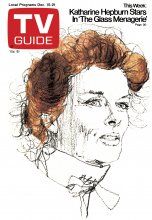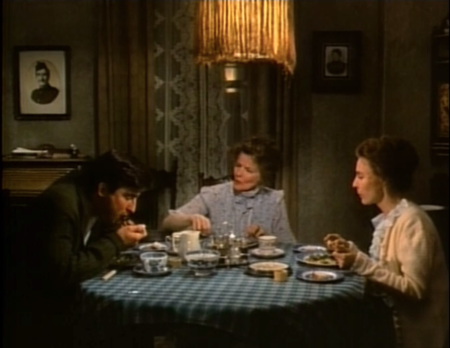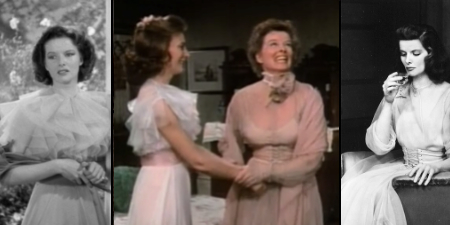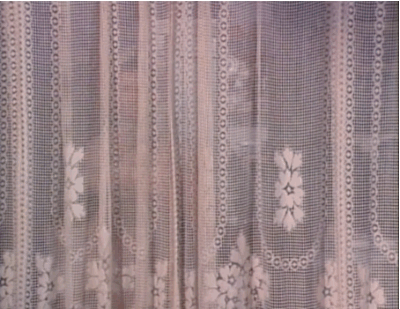Episode 40 of 52: In which Katharine Hepburn takes to TV to show that Laurette Taylor can eat her heart out.

Apparently Kate adapted to TV quickly. Mere months after her first two part television interview on The Dick Cavett Show, Katharine Hepburn returned to the small screen, this time to act. Director Anthony Harvey (last teamed with Kate directing The Lion in Winter) did away with the more fantastical elements of the play in order to get a more "natural" feel, relying on strong acting rather than stagecraft. Nonetheless, The Glass Menagerie remains a touching work of nostalgia and regret that comments in unexpected ways on its legendary lead actress’s life.
When The Glass Menagerie premiered in 1944, Laurette Taylor’s performance as Southern matriarch Amanda Wingfield effectively revolutionized American theatrical acting. In her second foray into Williams’ world, Katharine Hepburn steps out of Taylor’s long shadow. Hepburn's Amanda is not a dreamer, but a fighter. (The biggest shock: Katharine Hepburn, she of the infamous Bryn Mawr brogue, nearly conquers a Southern accent.) Kate plays the most Yankee Southern Belle; she speaks quickly and she demands rather than cajoles. As Kate plays her, Amanda uses her frequent escapes into memory as anecdotal proof that her current suffering is undeserved.
Trivia, nostalgia, and a good reason never to clean out your closet after the jump.
 Another explosive family dinner courtesy of Tennessee Williams.
Another explosive family dinner courtesy of Tennessee Williams.
It's a gamble to play Amanda with such conviction, and for the most part it works. Kate’s Amanda chafes against Sam Waterston’s Tom, who so clearly is a dreamer. And Amanda simple steamrolls over her daughter, Laura (dewy-eyed Joanna Miles, only limping slightly). By the time the gentleman caller (Michael Moriarty) arrives to upend their fragile peace, it feels not so much like an intrusion as a welcome distraction from the painful realities of the Wingfield household. All four actors would nab Emmy nominations for their performances, and they were well-earned.
Tennessee Williams' memory play on the Great Depression is a work of reflection, not just for Williams but also for Katharine Hepburn. Patricia Zipprodt (who has a great name for a costume designer) replicated or reused two gowns associated with early Hepburn. Kate herself wears the dress from her triumphant 1938 stage production of The Philadelphia Story, which only required a touch of letting out and an (honestly awful) neck corsage. More surprisingly, Joanna Miles’s dress is a close replica of one worn by Hepburn in one of her most financially successful 30s vehicles, Stage Door, which emphasizes just how much Joanna Miles looks like a young Kate.

For eagle-eyed audiences, it could be a happy bit of trivia to tuck away. But the costume choice also adds something metatextual both to the movie and to Kate’s career. Watching the Amanda flit around in the dress in which Katharine Hepburn had won her comeback almost four decades ago, I started reminiscing on Kate’s RKO career. Amanda Wingfield in this context becomes the anti-Kate, a woman just as convinced of her own magnificent exceptionalism, whose luck would never through as it had for Hepburn. There was, in the late part of the 1930s, a chance that Kate could have failed, and been left clinging to her memories and her carefully preserved costumes as Amanda does. But somehow, this makes Amanda Wingfield more dear. With nearly forty years and three Oscars between Kate and the 1930s, the past recedes into an unhappy memory rendered noble by the success that followed.
Memory tinges the sweet sadness of Tennessee Williams's work. Through the lens of nostalgia, the Wingfields’ petty quarrels and terrible poverty are imbued with a sense of longing and symbolism, though for him the past was a burden to bear. Hepburn, possibly more popular (or at least less controversial) in her 60s than she was in her 20s and 30s, could afford to look back on her early career with fondness. She never expressed the kind of regrets that Williams did--though she had some, she refused to name them. Instead, Kate looked forward as always. The Glass Menagerie marked the last “serious” play adaptation Kate performed onscreen, beginning the weirdest (and last) chapter of Kate’s career.
What do you think of our Yankee Southern Belle? Are you feeling nostalgia for Kate's earlier movies as our year draws to a close?

 Previous Week: A Delicate Balance (1973) - In which Katharine Hepburn stars in an Edward Albee play that's not Who's Afraid of Virginia Woolf? and does her first television interview.
Previous Week: A Delicate Balance (1973) - In which Katharine Hepburn stars in an Edward Albee play that's not Who's Afraid of Virginia Woolf? and does her first television interview.
Next Week: Love Among The Ruins (1975) - In which Katharine Hepburn does a TV movie with Laurence Olivier and George Cukor, which might have been disappointing if it wasn't so good.